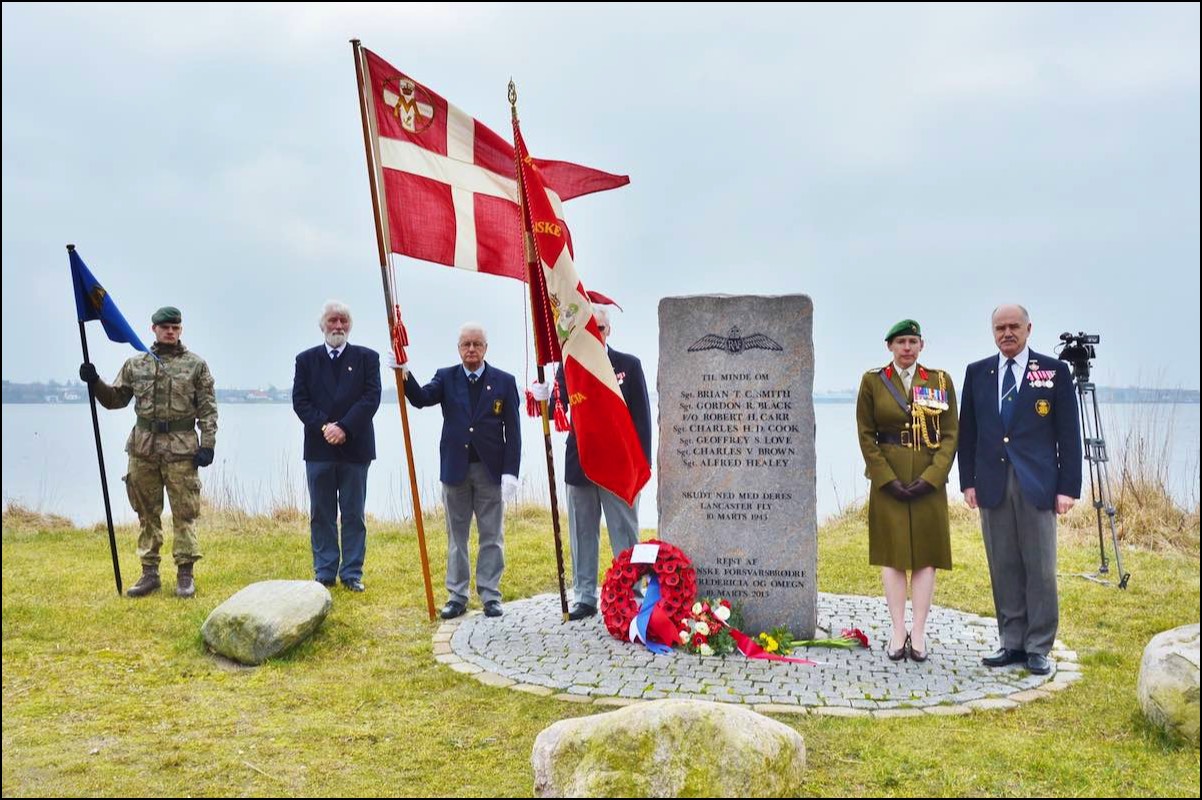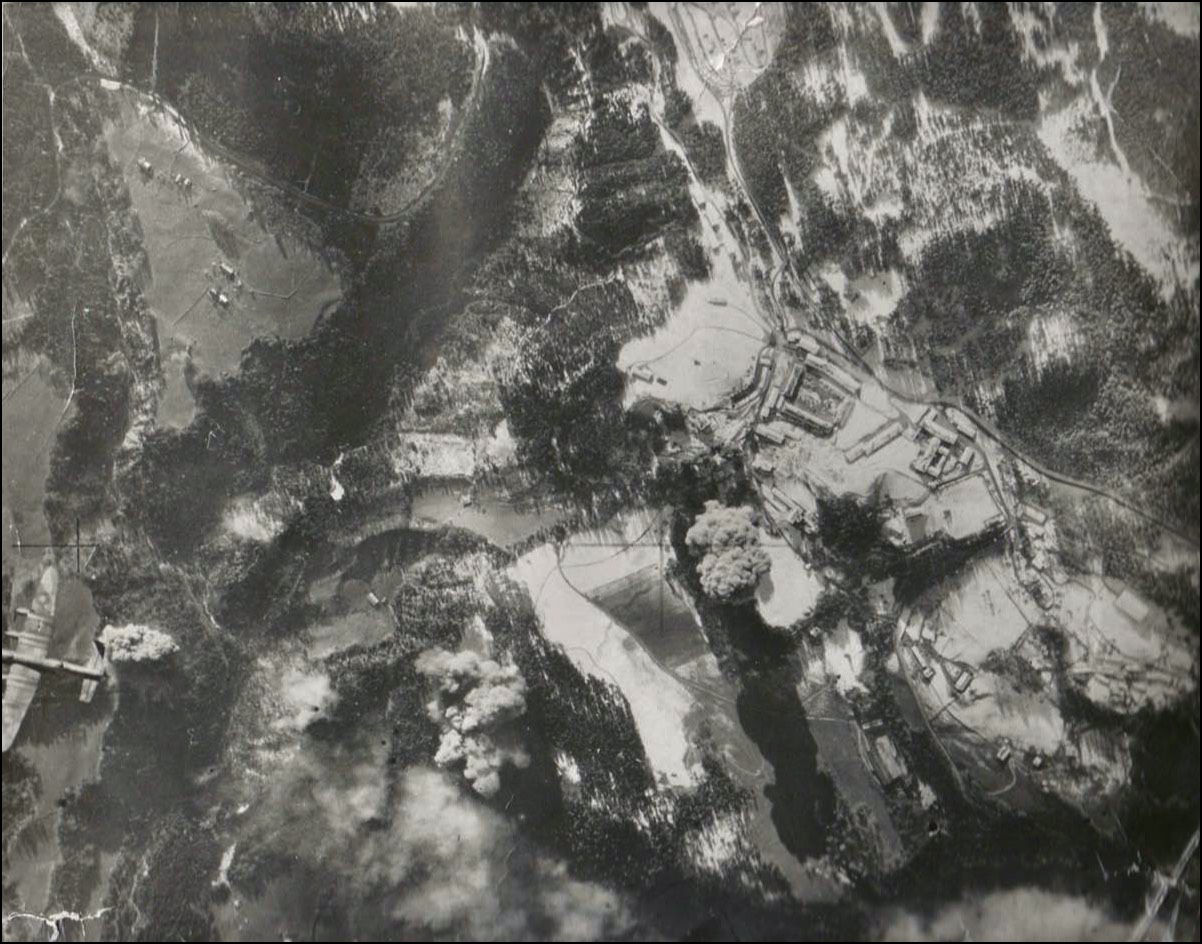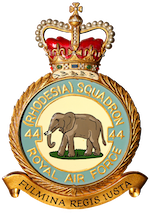
A ceremony in March 2016 at Fredericia, Denmark, commemorating the crew of Lancaster ED305. Colonel Sarah Johansen, representing the British Embassy is second from the right, standing next to Peer Petersen.
Letters
Dear Editor,
I have just finished reading the September issue of the newsletter and re-read again the small piece on page one, ‘Out of the DV Window’, and noticed your comments regarding the lack of information on the Canberra era.
I agree, very much with your sentiments. I was a member of 44 Squadron ground crew stationed at RAF Honington from 1955 to 1957. I was a National Serviceman and my rank and trade was Junior Technician, Navigational Instrument Fitter.
I was at Honington during the build up to the Suez Campaign and spent all the summer of 1956 servicing aircraft which were ferrying bombs from our bomb dump to Cyprus in preparation for the coming conflict (which, of course, we knew nothing about).
Like you, I have been surprised that so little information has been published about the life and times of the Canberra, which was a very successful aircraft sold to many countries. It was a lovely aircraft to work on, although I did have some difficult places to navigate myself regarding some of the instruments I had to service and maintain. Two in particular: the Detector Unit, located on the wingtip, providing information to the G4 electromagnetic compass; and the Bombsight Computer, located in the nose, where I had to lay prone in a very narrow space to set up the necessary calibrations.
I do hope there are still some remaining aircrew who can give their interesting tales of flying the aircraft. In particular, how they fared in action in Suez and Egypt. I heard that 44 Sqn bombers actually attacked Radio Cairo but it was never confirmed.
I shall always remember our aircrews’ helmets - light blue with a pink elephant on either side. I have included with this letter a copy of a short piece I wrote some 24 years ago, just after I joined the Association. It contains a few more of my experiences as a National Serviceman and my posting to 44 Squadron.
Since then I have also acquired a very good book, ‘The History and Development of the English Electric Canberra’, by Bruce Barrymore Halfpenny, published in 2005.
I conclude by wishing all my friends and comrades who worked on and flew Canberras. The best of luck and good health in the coming years.
Dave Stanley
A National Serviceman Remembers
Your correspondent Alan Mudge (Newsletter No 19) took me back to my own short time served in Bomber Command. as an ex-apprentice Machine Tool Fitter, I did not go in until I was twenty one. January 1955 saw me taking the early morning train from King’s Cross to that displaced persons camp the RAF called Cardington. After taking a trade test and collecting a miscellany of items and a uniform that only fitted at the edges, I was off the Stalag Bridgnorth …. and here came a rude awakening, contrary to the opinion of my erstwhile pals doing National Service in the Army, the RAF was definitely not cushy. I was to find that there were plenty of sadists known as DIs who were determined that their squadron would outdo the Guards regarding drill, in double quick time.
For eight brief but seemingly interminable weeks that winter we bashed the parade ground. And boy, what appetites we all developed! We always seemed to be hungry and who could ever forget those great evenings in the NAAFI consuming vast quantities of eggs, sausages, chips and beans …. after bulling the floor, the boots, the brass - in fact anything that didn’t move!
However, all good things come to an end, as they say, and eventually it was decided that we had learnt how to salute and recognise an officer when we saw one …. in fact I am sure that I heard a DI say, on our passing out parade, that we were quite smart, but maybe he was a trifle biased! The time had come to earn our crust!
While at Bridgnorth I had received my posting and had been informed of the trade that I had been selected for. The next stop was No 2 Technical Training School, RAF Melksham; the trade, that of Navigational Instrument Fitter. The course was for nine months, with phase tests every one or two weeks. If more than two tests were failed then the student was pulled from the course and re-flighted to the Regiment or Cook II - a great incentive to work hard and pass the course!
A very pleasant town was Melksham, with its environs Compton Basset (Teleprinter Training) and Yatesbury (Radar Training) close by and I can well remember the groups of RAF personnel in uniform hitch-hiking along the A4 to London on Saturday afternoons on a 36-hour pass. I have much to thank those maligned course instructors for - they created an interest in me for control systems, which I pursued after I left the RAF on demob.
At last the course was over and, thankfully, I had passed; a very green but very keen Junior Technician, Inst Fitt Nav. The posting was to RAF Honington in Suffolk, No 44 (Rhodesia) Squadron, No 3 Group, Bomber Command. Four squadrons were located there: Nos 9, 15, 44 and 57. All flew Canberra B2 aircraft. Aircrew and ground crew on 44 were a mixture of Regulars and National Servicemen. There was a great sense of belonging in 44 and always a competitive spirit to outdo the other squadrons on the station. Come the summer of 1956, much activity was experienced in ferrying 1000 lb bombs from the bomb dump to Cyprus in preparation for the ill-fated Suez invasion.
During this time we also had a visit from a high ranking dignitary from the air force of the USSR. The party arrived complete with champagne and caviar, which I helped to unload from the air transport craft in which they had arrived. All four squadrons of our aircraft were lined up on the perimeter track, complete with aircrew, for static display and inspection. Overhead a squadron of Hunters put on an aerial display whilst a Javelin (what a beautiful aircraft that was) and a brand new Valiant flew past.
By September/October time I was beginning to get ‘de-mob happy’. January 1957 and Civvy Street seemed to beckon from just around the corner. Then the roof fell in: Suez! Some of the Squadron had gone to Cyprus but those of us who had been left behind were told that it was only an exercise. Some exercise! I saw my de-mob fading into the far distant future, sentiments endorsed by ‘Chiefy’ with “You can kiss your de-mob goodbye now, you’re on active service, lad.“
However, it wasn’t to be and 44’s involvement, although active at the time of the invasion, was short-lived and the majority of the Squadron personnel were home by Christmas and indeed, all by January, when the whole Squadron attended a farewell booze-up to celebrate valedictions to three of its National Servicemen - snd if the other two lads can remember the occasion, I would dearly like to renew contact.
So ended my time in the RAF and on the Squadron, a two-year period that I will never forget and never regret. I made friends but, regretfully, over the years, lost contact with many of them. However, I do on a number of occasions meet ex-RAF National Servicemen and when we exchange views it is amazing how we all seem to have a positive opinion of our time in the Service and the good effect it had on our lives.
D A Stanley
27 March 1992
From our Antipodean Correspondent
For quite some time now, John Thompson, our ‘Purveyor of Perverse Stories from Down Under’ has been unusually quiet. However, he broke cover recently to tell me he is making a good recovery after a health setback in February of last year, but regrets he will be unable to make the reunion this year. It may be debatable, but some think his bizarre sense of humour has remained intact. You can judge for yourselves from this, his latest offering:
Constantly being broke and stuck in an unhappy marriage, a young husband decided to solve both problems by taking out a large insurance policy on his wife, with himself as the beneficiary, and then arranging to have her killed.
A 'friend of a friend' put him in touch with a nefarious, dark-side underworld figure who went by the name of 'Artie.' Artie explained to the husband that his going price for snuffing out of a spouse was $10,000.
The husband said he was willing to pay that amount but that he wouldn't have any cash on hand until he could collect his wife's insurance money. Artie insisted on being paid at least something up front, so the man opened his wallet, displaying the single dollar coin that rested inside. Artie sighed, rolled his eyes and reluctantly agreed to accept the dollar as down payment for the dirty deed.
A few days later, Artie followed the man's wife to the local Aldi. There, he surprised her in the produce department and proceeded to strangle her with his gloved hands. As the poor unsuspecting woman drew her last breath and slumped to the floor, the manager of the produce department stumbled unexpectedly onto the murder scene. Unwilling to leave any living witnesses behind, Artie had no choice but to strangle the produce manager as well.
However, unknown to Artie, the entire proceedings were captured by the hidden security cameras and observed by the shop's security guard, who immediately called the police. Artie was caught and arrested before he could even leave the premises.
Under intense questioning at the police station, Artie revealed the whole sordid plan, including his unusual financial arrangements with the hapless husband, who was also quickly arrested.
The next day the following headline appeared in the local newspaper: “ARTIE CHOKES 2 FOR $1 AT ALDI”.

No 44 Squadron’s Operational History was compiled from accounts by air and ground crew who flew and worked on the Squadron during both World Wars. The annex contains many accounts of aircrew who survived bale outs and some who evaded capture while on the run in occupied territory. It recalls vividly the experiences of those unfortunate enough to spend much of the Second World War in prison camps.
The title of the book comes from the Squadron’s motto “Fulmina Regis Iusta” (The King’s Thunderbolts are Righteous). There are 255 A4 pages and it is in a laminated softback form. The recommended retail price is £24, plus postage and packing but the price to UK members will be discounted at £17.00, inclusive of postage and packing (Overseas members will have to be charged £19.00). To order a copy of this excellent book please contact our Secretary:
Squadron Leader H M Horscroft (Ret’d)
9 Church Lane, Eagle, Lincoln LN6 9DJ
Telephone: 01522 868 653
E-mail: henry.horscroft@btinternet.com

A vertical of the ‘Eagle’s Nest’ Berchtesgaden, taken in April 1945.
Note the effectiveness of the camouflage paint scheme on the Lancaster disappearing out of shot to the left.
